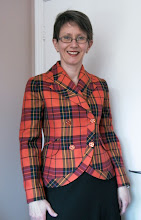I finished my latest knitting project. Here it is on
Ravelry. It's a cotton top and I fear it may become an orphan. It's too dark to coordinate with grey or black. Why didn't I anticipate this?

This is the same cotton slub yarn I used last year for some rather more successful items. But this is heavier. It's knitted with four strands of the lace-weight yarn that I used single for my
Ethereal top and double for my
Featherweight cardigan.
Unfortunately, the tendency of this yarn to bias is not manageable at this weight. I shall have to learn to live with a top that twists.
I went to Montreal on the weekend to meet up with some other bloggers. Strangely, I do not have a single photo of this gathering! Among the group were
Caro (our fearless leader),
Vicki,
Anne-Marie,
Claire and
Julie. Heather Lou of
Closet Case Patterns also joined us after work on her very last day. Watch for more from her, coming soon!
For anyone who is interested in fabric shopping in Montreal, Caro prepared guides to two distinct fabric shopping areas in the city:
St-Hubert Street and
Chabanel. To shop Chabanel, where we went on Friday, you have to have the addresses since most of the stores are well-hidden on the 4th or 7th floor of several non-descript buildings. Most of the businesses are not open on weekends, unfortunately. I demonstrated remarkable discipline, picking up only two pieces.

One is tentatively earmarked for
Vogue 8904 - the Marcy Tilton shingle dress.
Yikes that model is long and skinny!
I had a look at the instructions and noticed that each of the shingles is sewn on a full dress piece, so this dress has at least 2 layers of fabric on every square inch. Also, the lower edges of each shingle are supposed to be left raw.
I will look in my stash for a lightweight and smooth knit to use as a base since the fabric I bought has texture. Also, I will experiment with small hems since I have no interest in the tightly rolled edges that my jersey fabric will probably make (especially after washing).
I'll get right on that project since summer is fleeting.


Meanwhile, Vogue 1385 is in time-out. I cut the longer length and it is practically a dress. I need to decide how much to remove so I can wear it as a shirt (in or out). I think I'll make a tie belt for it. And then I need to figure out what to do about buttons. And, more to the point, buttonholes. I don't really look forward to sewing them in this fabric.
.
Given the properties of my fabric, I had decided to sew French seams using a narrow serged seam in the first pass. Imagine my surprise to see that this is exactly what the instructions say to do! It worked very well.
The order of construction is strange. You sew the raglan seams together, then apply the facings, and only after that do you make the darts that shape the neckline. It is, in consequence, impossible to try this on as you are making it. At left, I'm pinning the darts out prior to applying the facings to see if it is going to work.
(Those hairy white blobs you can see are little pieces of white paper labels holding down poorly-done tailors tacks - the only way I could think of to mark the many points that needed marking on my strange fabric.)
I made the facings from grey silk organza to avoid bulk and to keep the facing as invisible as possible. It's not my best ever work, but will do.

As for style/fit, my only dislikes are that the armscye is pretty low and I find the transition from the pleated/ruffly front neckline to the smooth back neckline a little abrupt. It's a bit too "
coffin clothes" for my liking.
At right is the most graphic view of that. If I was going to make this again, I would monkey with the pleat at the shoulder to make it less full, and add at least a couple more pleats at the back raglan seam and somewhere in the back neckline. Not to add fullness or shaping, just enough to keep the effect going.
























